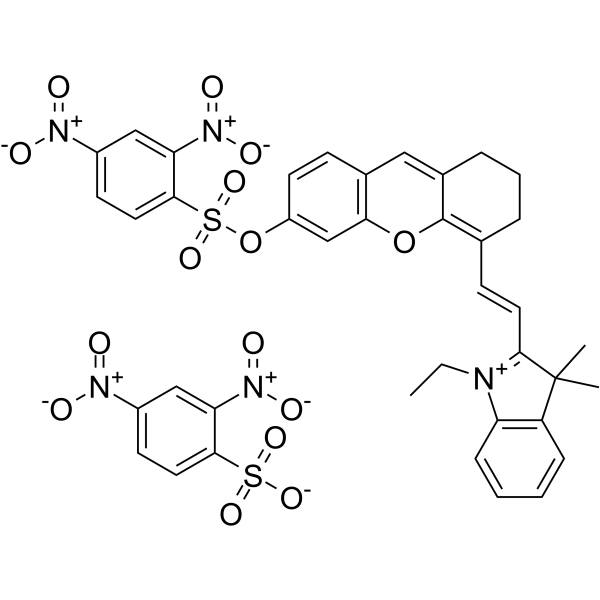荧光染料Dye Reagents NIR-Thiol dinitrobenzenesulfonate;
NIR-Thiol dinitrobenzenesulfonate 是一种可透过细胞的 NIR 荧光硫醇传感器。NIR-Thiol dinitrobenzenesulfonate 在 NIR 区域内同时具有吸收和发射作用。当在 NIR 区域激发时,NIR-Thiol dinitrobenzenesulfonate 对硫醇产生较大的启动 NIR 荧光信号,还能够对活细胞和小鼠中内源性产生的硫醇进行成像。

NIR-Thiol dinitrobenzenesulfonate Chemical Structure
| 规格 | 是否有货 | ||
|---|---|---|---|
| 100 mg | ; | 询价 | ; |
| 250 mg | ; | 询价 | ; |
| 500 mg | ; | 询价 | ; |
* Please select Quantity before adding items.
| 生物活性 |
NIR-Thiol dinitrobenzenesulfonate has both absorption and emission in the NIR region. NIR-Thiol dinitrobenzenesulfonate responds to thiol with a large turn-on NIR fluorescence signal upon excitation in the NIR region. NIR-Thiol dinitrobenzenesulfonate is capable of imaging endogenously produced thiol in living cells and mice[1]. |
|---|---|
| 体外研究 (In Vitro) |
NIR-Thiol dinitrobenzenesulfonate is highly selective to typical small molecular weight biological thiols (Cys, Hcy, and GSH) over other biorelevant species, such as Phe, Gly, Arg, Lys, Tyr, Leu, glucose, Ser, and Val[1]. MCE has not independently confirmed the accuracy of these methods. They are for reference only. |
| 体内研究 (In Vivo) |
A different amount (0, 20, 40, or 160 nanomoles) of NIR-Thiol dinitrobenzenesulfonate is injected into the ip cavity of mice. Strong fluorescence is noted for the mice injected with 20 nanomoles of NIR-Thiol dinitrobenzenesulfonate, whereas almost no fluorescence is observed in the control mice without being injected with the sensor. In addition, the mice injected with a higher amount (40 or 160 nanomoles) of NIR-Thiol dinitrobenzenesulfonate provids brighter fluorescence. A very large signal-to-noise contrast ratio (ca. 700-fold enhancement) is observed for the mice injected with 20 nanomoles of NIR-Thiol dinitrobenzenesulfonate. In addition, the signal-to-noise contrast ratio jumped to ca. 2900- or 7400-fold enhancement when the mice are injected with 40 or 160 nanomoles of NIR-Thiol dinitrobenzenesulfonate, respectively[1]. MCE has not independently confirmed the accuracy of these methods. They are for reference only. |
| 分子量 |
875.83 |
| Formula |
C39H33N5O15S2 |
| 运输条件 |
Room temperature in continental US; may vary elsewhere. |
| 储存方式 |
Please store the product under the recommended conditions in the Certificate of Analysis. |
| 参考文献 |
|
